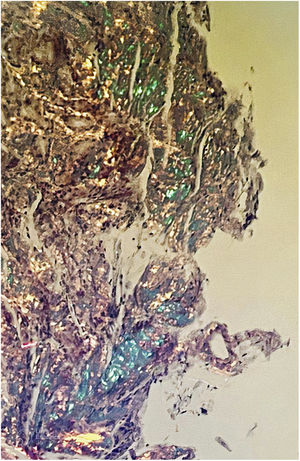An 86-year-old man was referred to our department for endoscopic study due to a 3- month history of non-bloody fatty diarrhea, anorexia, and 15 kg weight loss. He had a year long history of heart failure, with reduced ejection fraction, and dementia syndrome. Iron-deficiency anemia, hypomagnesemia, and severe hypoalbuminemia were apparent in the laboratory work-up, with no other abnormalities. Esophagogastroduodenoscopy showed friable mucosa with granular elevations and thickened and very prominent duodenal folds in the second part of the duodenum (Fig. 1). Biopsy specimens showed Congo red-stained amyloid deposits, with apple-green birefringence, under polarized light (Figs. 2 and 3). Cardiac scintigraphy with 99mTc-DPD showed clearly evident myocardial uptake, suggesting wild-type senile transthyretin amyloid deposits. The rest of the etiologic studies yielded negative results. Gastrointestinal senile systemic amyloidosis was diagnosed. Only symptomatic treatment was given due to the patient’s age and lack of evidence-based therapies in arresting or slowing this condition. The patient died 3 months after diagnosis.
Because no personal data that could identify the patient were published, approval by an ethics committee was not required, nor was informed consent needed.
Financial disclosureNo specific grants were received from public sector agencies, the business sector, or non-profit organizations in relation to this article.
AuthorshipAG reviewed the literature and wrote the manuscript; MAS reviewed the literature; HV reviewed and approved the final manuscript.
Conflict of interestThe authors declare that there is no conflict of interest.
Please cite this article as: Gonçalves A, Azevedo-Silva M, Vasconcelos H. Amiloidosis senil. Hallazgos endoscópicos como punto de partida para el diagnóstico. Rev Gastroenterol Méx. 2023;88:287–288.









